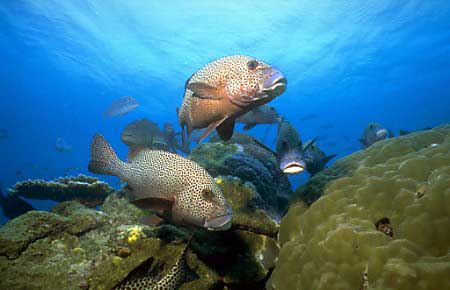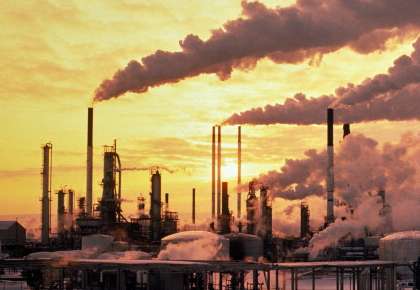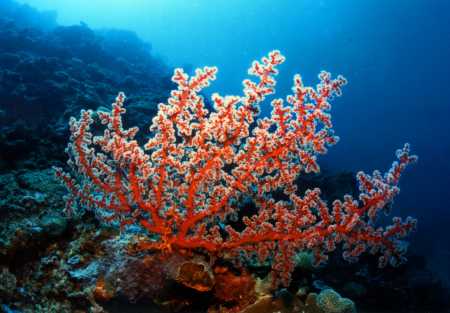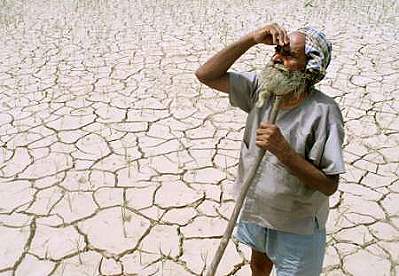| overview home page |
| peace, war & conflict |
| human rights |
| development & poverty |
| environment |

Forests
Half of the forests that originally covered 46% of the Earth's land surface are gone. Only one-fifth of the Earth's original forests remain pristine and undisturbed.
In North America, 56% of the coastal temperate rainforests, once extending from California to Alaska, have been destroyed.
Latin American Forests are being lost at alarming rates. The rate of forest loss in Mexico is estimated at 600,000 to 2.5 million acres per year. The lush forests that blanketed half of Panama at mid-century may cover only 10% of the country by the year 2000.
Natural Resources Defense Council (? / RAN)
Forests cover about a quarter of the world's land surface, excluding Greenland and Antarctica. Global forest cover has been reduced by 20 percent since pre-agricultural times, and possibly as much as 50 percent. Forest area has increased slightly since 1980 in industrial countries, but has declined by almost 10 percent in developing countries. Tropical deforestation probably exceeds 130,000 square kilometers a year. Less than 40 percent of forests globally are relatively undisturbed by human action.
World Resources Institute
Rainforests
Rainforests cover 2% of the Earth's surface, or 6% of its land mass, yet they house over half the plant and animal species on Earth. They originally covered at least twice that area. Rainforests are being destroyed at a staggering rate. According to the National Academy of Science, at least 50 million acres a year are lost, an area the size of England, Wales and Scotland combined.
Despite the small land area they cover, rainforests are home to about half of the 5 to 10 million plant and animal species on the globe. Rainforests also support 90,000 of the 250,000 identified plant species.
Rainforest Action Network

Global Warming & Climate Change
If present rates of emissions of carbon dioxide continue, the Earth will experience a lC (1.8F) warming by 2030 at the latest, and a 3C (5.4F) increase in temperature before the end of the next century. This amounts to a warming rate 10 to 100 times more rapid than the fastest warming period in the last 10,000 years. Global warming would have tremendous consequences including:
Widespread extinction of plant and animal species.
Sea level rise and coastal flooding. By 2050, the sea level will rise approximately 1.5 meters, flooding low lying areas. With as much as 50 percent of the world's population settled in coastal communities, it is estimated that by this time 150 million people will be driven from their homes and become environmental refugees. They would all irreversibly lose their land and homes.
Adverse impact on agriculture.
Increases in severe storms such as hurricanes, cyclones, and typhoons.
Rainforest Action Network
The ten warmest years have occurred since 1983, with seven of them since 1990. Recent evidence shows the 20th century was the warmest in the last 1,000 years. The 1990s were the warmest decade and 1998 was the single warmest year of the past millennium.
U.S. Environmental Protection Agency
Scientists predict that continued global warming on the order of 2.5-10.4 degrees Fahrenheit over the next 100 years is likely to result in: a rise in sea level between 3.5 and 34.6 in. leading to more coastal erosion, flooding during storms and permanent inundation; severe stress on many forests, wetlands, alpine regions, and other natural ecosystems; greater threats to human health as mosquitoes and other disease-carrying insects and rodents spread diseases over larger geographical regions; disruption of agriculture in some parts of the world due to increased temperature, water stress and sea-level rise in low-lying areas such as Bangladesh or the Mississippi River delta.
Union of Concerned Scientists

Biodiversity & Species Extinction
Biological Diversity -- or "biodiversity" -- is the totality of genes, species, and ecosystems in a region.
World Resources Institute
The Earth's species are dying out at an alarming rate, up to 1000 times faster than their natural rate of extinction. Some scientists estimate that as many as 137 species disappear from the Earth each day, which adds up to an astounding 50,000 species disappearing every year.
Rainforest Action Network
Species have been disappearing at 50-100 times the natural rate, and this is predicted to rise dramatically. Based on current trends, an estimated 34,000 plant and 5,200 animal species - including one in eight of the world's bird species - face extinction.
Convention on Biological Diversity
The best estimates are that between 10 and 20 percent of all species will be driven to extinction in the next 20 to 50 years. The current and impending rate of human-caused extinctions is conservatively estimated to be 100 to 1,000 times the background extinction rate.
More than 2,000 species of birds (20 to 25 percent of the world's total) have become extinct through human action in the past two thousand years. In the past four hundred years, we have recorded extinctions of 484 species of animals (including 163 species of birds and mammals) and 654 species of plants. Almost all of these extinctions are known to have been caused by human actions.
Union of Concerned Scientists
Biodiversity is degraded and lost through such activities as the large-scale clearing and burning of forests, overharvesting of plants and animals, indiscriminate use of pesticides, draining and filling of wetlands, destructive fishing practices, air pollution, and the conversion of wildlands to agricultural and urban uses.
World Resources Institute

Oceans & Marine Ecosystems
We are in the midst of a global marine crisis. Earth's coastal and marine resources, and the ecosystems upon which they depend, are showing signs of collapse.
World Resources Institute
The ocean covers 71 percent of the surface of our world and plays a vital role in maintaining biodiversity, regulating climate and weather patterns, and providing food and jobs for millions of people worldwide.
As a result of destructive human activity, however, the health of our oceans and the life they support is in jeopardy. Commercial whaling much reduced from its former scale but still in existence, has severely depleted whale populations worldwide, driving some to the brink of extinction. Fish stocks are plummeting in virtually every ocean and sea. Seabirds, hundreds of thousands of sea turtles and marine mammals are entangled and drowned by irresponsible fishing practices every year.
Greenpeace USA

Coral Reefs
Covering less than 0.2% of the ocean floor, coral reefs contain perhaps 1/4 of all marine species.
Coral reefs are among the most endangered ecosystems on earth. Coral reefs in 93 of the 109 countries containing them have been damaged or destroyed by human activities. In addition, human impacts may have directly or indirectly caused the death of 5-10% of the world's living reefs, and if the pace of destruction is maintained, another 60% could be lost in the next 20-40 years.
Environmental Defense Fund
Freshwater Systems
Freshwater systems encompass a wide range of habitats, including rivers, lakes, and wetlands. Humans also rely heavily on groundwater, which is the only source of freshwater in some parts of the world.
The world's freshwater systems are so degraded that its ability to support human, plant and animal life is greatly in peril. As a result, many freshwater species are facing rapid population decline or extinction, and an increasing number of people will face serious water shortages.
By 2025, at least 3.5 billion people or nearly 50 percent of the world's population will face water scarcity.
More than 20 percent of the world's known 10,000 freshwater fish species have become extinct, been threatened, or endangered in recent decades.
World Resources Institute
Coastal Ecosystems
Forty percent of the world's population lives within 100 kilometers of a coastline, an area that accounts for only about 20 percent of the land mass. Population increase and conversion for development, agriculture, and aquaculture are reducing mangroves, coastal wetlands, seagrass areas, and coral reefs at an alarming rate. Fish and shellfish provide about a sixth of the animal protein consumed by people worldwide. A billion people, mostly in developing countries, depend on fish for their prime source of protein. Coastal ecosystems have already lost much of their capacity to produce fish because of overfishing, destructive trawling techniques, and destruction of nursery habitats.
World Resources Institute
Overfishing
World fisheries face a grim forecast. Forty-five years of increasing fishing pressure have left many major fish stocks depleted or in decline.
Sixty percent of the world's important fish stocks are "in urgent need of management" to rehabilitate them or keep them from being overfished. Furthermore:
35 percent of the most important commercial fish stocks show a pattern of declining yields and require immediate action to halt overharvesting.
Another 25 percent show steady yields but are being fished at their biological limit and are vulnerable to declines if fishing levels increase.
The harvest of overexploited fish stocks has dropped 40 percent in only 9 years.
World Resources Institute, Resources at Risk

Wilderness & Land
Desertification
Desertification threatens nearly one quarter of the land surface of the globe. The environmental impacts of desertification include a reduction in crop yields, a loss of plants and a deterioration in the quality of plant foodstuffs available to humans and animals.
The Guardian newspaper, Desertification special report, The Arid Expansion
Desertification is the degradation of drylands. It involves the loss of biological or economic productivity and complexity in croplands, pastures, and woodlands. It is due mainly to climate variability and unsustainable human activities. Seventy percent of the world's drylands are degraded. Desertification is considered a major global environmental issue largely because of the link between dryland degradation and food production. If desertification is not stopped and reversed, food yields in many affected areas will decline. Malnutrition, starvation, and ultimately famine may result.
United Nations Secretariat of the Convention to Combat Desertification

Wildlife
Thousands of species of plants and animals are under increasing threat. Every day, added pressures such as loss of habitat, illegal trade, over-hunting, pollution, and the effects of climate change and economic development take their toll on the world's wildlife.
Some 34,000 plant species, or 12.5 per cent of the world's flora, are under threat. Giant pandas have lost half their habitat in the past few decades. The world lost more than 90 per cent of its tiger population in the 20th century: only about 5,000 remain. In the Pacific, leatherback turtles face extinction. Javan and northern white rhinos are the most threatened large mammals on Earth: only a few dozen remain.
World Wide Fund for Nature, Species Program
Wildlife Trade
The international trade in wildlife is big business, estimated to be worth billions of dollars annually and to involve more than 350 million plants and animals every year. Along with the loss of habitat and increased local exploitation of wildlife resources, unregulated international trade can pose a major threat to the survival of threatened and endangered species.
TRAFFIC, WWF / IUCN
Energy
Global energy use has risen nearly 70 percent since 1971 and is poised to continue its steady increase over the next several decades, fueled by economic expansion and development.
Along with rising energy use comes a concomitant increase in greenhouse gas emissions from fossil fuels and an anticipated increase in global warming. Fossil fuels supply roughly 90 percent of the world's commercial energy; energy-related emissions account for more than 80 percent of the carbon dioxide (CO2) released into the atmosphere each year. By 2010, IEA projects that global energy consumption -- and annual CO2 emissions -- will have risen by almost 50 percent from 1993 levels.
World Resources Institute
Urban Growth
The world’s urban population is currently growing at four times the rate of the rural population. Between 1990 and 2025, the number of people living in urban areas is projected to double to more than 5 billion; if it does, then almost two thirds of the world’s population will be living in towns and cities. An estimated 90 percent of the increase will occur in developing countries.
The current pace and scale of change—over 60 million people are added to urban populations each year—often strain the capacity of local and national governments to provide even the most basic services to urban residents. An estimated 25 to 50 percent of urban inhabitants in developing countries live in impoverished slums and squatter settlements, with little or no access to adequate water, sanitation, or refuse collection. In such situations, both environmental quality and human health and well-being are at risk.
World Resources Institute
Transportation
Transportation of all types already accounts for more than one quarter of the world's commercial energy use. Vehicles are major sources of urban air pollution and greenhouse gas emissions. Currently, the transport sector consumes about one half of the world's oil production, the bulk of it as motor fuel.
In 1950, there were only 70 million cars, trucks, and buses on the world's roads. By 1994, there were about nine times that number, or 630 million. If this kind of linear growth continues, by the year 2025 there will be well over 1 billion vehicles on the world's roads
In China there are only about 8 vehicles per 1,000 persons, and in India, only 7 per 1,000 persons; by contrast, there are about 750 motor vehicles per 1,000 persons in the United States
In developing countries, the growing use of internal combustion vehicles, especially in urban areas, will increase congestion, raise the demand for oil, worsen air pollution, and increase emissions of a variety of greenhouse gases, including methane, ozone, carbon monoxide, nitrous oxide, and, most important, CO2.
Worldwide, motor vehicle emissions account for more than 15 percent of global fossil fuel CO2 releases. Because of their large vehicle fleets, developed countries are responsible for a commensurately large share of emissions. In 1993, developed countries accounted for about two thirds of total world CO2 emissions from motor vehicles, although these countries represented only 16 percent of the world's population.
World Resources Institute